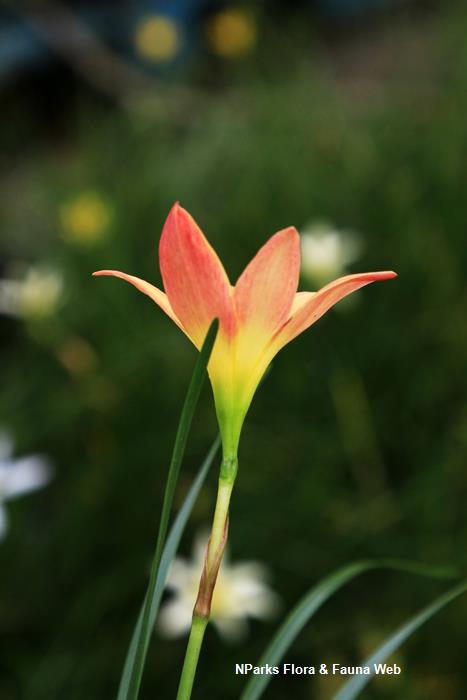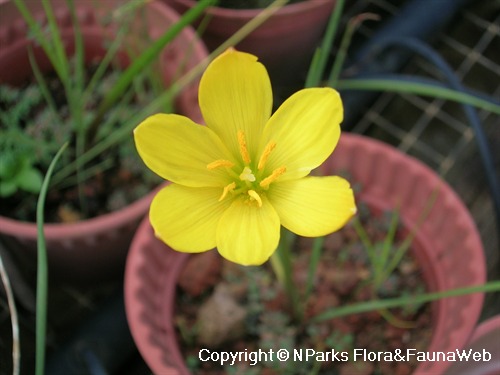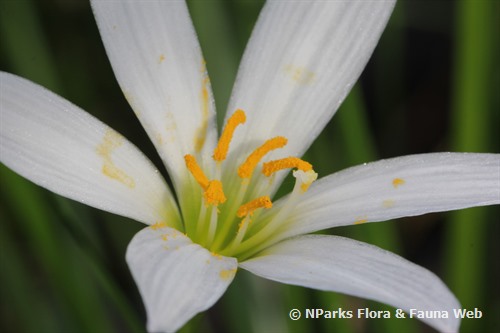
Name
Classifications and Characteristics
| Plant Division | Angiosperms (Flowering Seed Plants) |
|---|---|
| Plant Growth Form | Herbaceous Plant |
| Lifespan (in Singapore) | Perennial |
| Mode of Nutrition | Autotrophic |
| Plant Shape | Grassy |
| Maximum Height | 30 cm |
| Maximum Plant Spread / Crown Width | 30 cm |
Biogeography
| Native Habitat | Terrestrial |
|---|---|
| Preferred Climate Zone | Tropical |
| Local Conservation Status | Non-native |
Description and Ethnobotany
| Growth Form | Perennial herb forms from a bulb into a grassy clump up to 30 cm high and 30 cm wide. |
|---|---|
| Flowers | Funnel-shaped flowers are light orange to peach with a bright yellow centre. |
| Fruit | Most Zephyranthes cultivars are unlikely to produce fruit and set seed. Species in the genus Zephyranthes bear a capsule fruit containing black seeds. |
| Cultivation | It grows best in well-drained soil with regular watering, but handles alternating periods of wet and dry spells well. It tends to bloom when there is a dry spell followed by heavy rain, but the flowers last only up to a few days. The top of the bulb should be planted about 3 cm below the soil surface and spaced 5-10 cm apart from one another. |
| Etymology | The genus Zephyranthes comes from the Greek words for west wind ('Zephyros') and flower ('anthos'). |
Landscaping Features
| Desirable Plant Features | Ornamental Flowers |
|---|---|
| Landscape Uses | Flowerbed / Border, Skyrise / Balcony |
| Usage Hazard - Cons | Toxic Upon Ingestion |
| Usage Hazard - Cons Remarks | All parts of the plant contain toxic alkaloids and must not be consumed. |
Plant Care and Propagation
| Light Preference | Full Sun, Semi-Shade |
|---|---|
| Water Preference | Moderate Water |
| Plant Growth Rate | Fast to Moderate |
| Propagation Method | Storage Organ (Bulb) |
| Planting Distance | 5 cm to 10 cm |
Foliar
| Foliage Retention | Evergreen |
|---|---|
| Mature Foliage Colour(s) | Green |
| Mature Foliage Texture(s) | Glossy / Shiny |
| Foliar Type | Simple / Unifoliate |
| Foliar Shape(s) | Non-Palm Foliage (Linear) |
| Foliar Venation | Parallel |
| Foliar Margin | Entire |
| Foliar Apex - Tip | Acute |
| Foliar Base | Truncate / Square |
| Typical Foliar Area | Notophyll ( 20.25cm2 - 45 cm2 ) |
Floral (Angiosperm)
| Flower & Plant Sexuality | Bisexual Flowers |
| Flower Colour(s) | Orange, Yellow / Golden |
|---|---|
| Flower Texture(s) | Smooth |
| Flower Grouping | Solitary |
| Flower Location | Terminal |
| Flower Symmetry | Radial |
| Individual Flower Shape | Funnelform / Funnel-shaped |
Image Repository
Others
| Master ID | 33927 |
|---|---|
| Species ID | 8343 |
| Flora Disclaimer | The information in this website has been compiled from reliable sources, such as reference works on medicinal plants. It is not a substitute for medical advice or treatment and NParks does not purport to provide any medical advice. Readers should always consult his/her physician before using or consuming a plant for medicinal purposes. |






